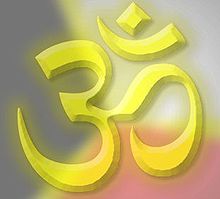- Mandukya Upanishad
-
The Mandukya Upanishad is the shortest of the Upanishads – the scriptures of Hindu Vedanta. It is in prose, consisting of twelve verses expounding the mystic syllable Aum, the three psychological states of waking, dreaming and sleeping, and the transcendent fourth state of illumination.
This Upanishad has been greatly extolled. The Muktikopanishad, which discusses other Upanishads, says that the Mandukya Upanishad alone is enough for salvation. According to Radhakrishnan [1] it contains the fundamental approach to reality.
It was compiled, under the influence of Mahayana Buddhism, in the 1st or 2nd centuries AD, and contains Buddhist terms and modes of expression..[2]
Contents
About the Upanishad
The name, "Mandukya" may have come about for several reasons:
- Attribution to a sage called Manduka. Manduka means "son of Manduki" and a seer with this metronymic is mentioned in the Brihadaranyaka Upanishad along with the Mandukeyas, his disciples. The Mandukeyas figure in the Bhagavata Purana as the receivers of a branch of the Rig Veda from Indra. This group of seers also figures in the Rig Veda itself: their hymns are mostly connected with lingustics.[3] A text on the etymology of Vedas with the name "Manduki Shiksha" deals with the notes of the musical scale.
- Manduka is also a type of yoga – a "particular kind of abstract meditation in which an ascetic sits motionless like a frog".[4] Mandukasana is one of the asanas (postures) described in yoga.
Aum in the Mandukya Upanishad
Part of a series on Hindu scriptures 
Vedas Rigveda · Samaveda
Yajurveda · AtharvavedaVedangas Shiksha · Chandas
Vyakarana · Nirukta
Kalpa · JyotishaUpanishads Rig vedic
AitareyaPuranas Brahma puranas
Brahma · Brahmānda
Brahmavaivarta
Markandeya · BhavishyaItihasa Mahabharata (Bhagavad Gita) Other scriptures Manu Smriti
Artha Shastra · Agama
Tantra · Sūtra · Stotra
Dharmashastra
Divya Prabandha
Tevaram
Ramcharitmanas
Yoga VasisthaScripture classification Śruti · Smriti Timeline Hindu texts There are three mātrās ("letters", syllabic instants in prosody) in the word aum : ‘a’, ‘u’ and ‘m’. The ‘a’ stands for the state of wakefulness, where we experience externally through our mind and sense organs. The ‘u’ stands for the dream state, in which inward experiences are available. In the state of deep sleep, represented by the sound ‘m’, there is no desire and consciousness is gathered in upon itself.
But there is a fourth, transcendent state, that of one "who is neither inwardly nor outwardly aware, nor both inward and outward, nor with consciousness infolded on itself.... who is unseen and ineffable, ungraspable, featureless, unthinkable and unnameable." The fourth state (turīya avasthā) corresponds to silence as the other three correspond to AUM. It is the substratum of the other three states. It is referred to as atyanta-shunyata (absolute emptiness).[5]
From the fact that many Buddhist terms are used in explaining the fourth state, it is clear that this view was established under the influence of the Mahayana Buddhist concept of emptiness.[5]
Commentary by Gaudapada
The first extant metrical commentary on this Upanishad was written by Gaudapada, before the time of Adi Shankara. This commentary, called the Māndūkya-kārikā, is the earliest known systematic exposition of advaita Vedanta. When Shankara wrote his commentary on Māndūkya Upanishad he merged the Kārikā of Gaudapada with the Upanishad and wrote a commentary on the Kārikā also. Scholars hold the Karika as well as Shankara's Commentary on it in high esteem.
Gaudapada deals with perception, idealism, causality, truth, and reality. In the fourth state of consciousness – turiya – the mind is not simply withdrawn from the objects but becomes one with Brahman. In both deep sleep and transcendental consciousness there is no consciousness of objects but the objective consciousness is present in an unmanifested 'seed' form in deep sleep, while it is transcended in turīya. Specifically, if one identifies the wordless state with turīya and meditates, one realizes the true self and 'there is no return to the sphere of empirical life'.[6]
References
- ^ S. Radhakrishnan. The Principal Upanishads. George Allen and Unwin. 1969
- ^ Hajime Nakamura, Trevor Leggett, A history of early Vedānta philosophy, Part 2. Reprint by Motilal Banarsidass Publ., 2004 page 284-6.
- ^ Phonology: Critical Concepts by Charles W. Kreidler
- ^ Monier-Williams.
- ^ a b Hajime Nakamura, Trevor Leggett, A history of early Vedānta philosophy, Part 2. Reprint by Motilal Banarsidass Publ., 2004 page 285.
- ^ Swami Nikhilananda: Mandukyopanishad with Gaudapada’s Karika and Sankara’s Commentary. Shri Ramakrishna Ashrama, Mysore. Sixth edn. 1974
Further reading
- Eight Upanishads. Vol.2. With the commentary of Sankaracharya, Tr. By Swami Gambhirananda. Advaita Ashrama, Calcutta, 1990.
- V. Krishnamurthy. Essentials of Hinduism. Narosa Publishing House, New Delhi. 1989
- Swami Rama. Enlightenment Without God [commentary on Mandukya Upanishad]. Himalayan International Institute of Yoga Science and Philosophy, 1982.
- Sri Aurobindo, The Upanishads [1]. Sri Aurobindo Ashram, Pondicherry. 1972.
External links
- GRETIL etext
- Mandukya Upanishad, Full etext from wikisource (Sanskrit).
- www.hinduwebsite.com, The Mandukya Upanishad English Translation
- Mandukya Upanishad with Gaudapada Karika
- [2], Musical version of Mandukya Upanishad Composed by Pandit Jasraj.
See also
- Adi Shri Gauḍapādāchārya
- Adi Shri Shankaracharya
- Advaita
- Shri Gaudapadacharya Mutt
- Shri Govinda Bhagavatpadacharya
Categories:
Wikimedia Foundation. 2010.

